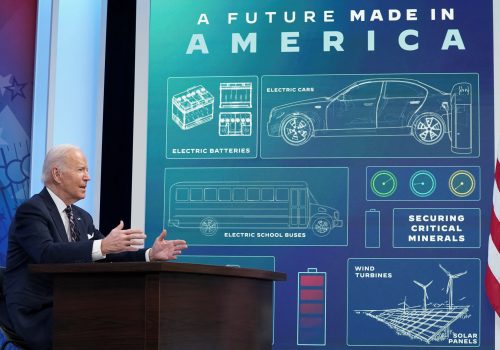Alternative battery chemistries and diversifying clean energy supply chains
The energy transition from fossil fuels to low-carbon energy sources will stimulate great demand for energy storage, and batteries will play an essential role in enabling the electrification of the transportation sector and reducing the intermittency of renewable electricity generation in the power sector. Presently, lithium-ion batteries predominate in both electric vehicle and grid storage applications. However, the continued expansion of these sectors will drive demand for minerals in the lithium-ion battery supply chain by a staggering degree.
Demand for lithium alone is projected to grow by 42 times from 2020 to 2040 and could reach a structural undersupply with a deficit of 1.75 million metric tons by 2030. Geopolitical risks also abound in the battery value chain. Russia controls 21 percent of global class 1 nickel production, and China controls 80 percent of global cobalt processing capacity.
Utilizing battery chemistries with more-readily available supply inputs, as an alternative to lithium-ion batteries, could alleviate supply-chain concerns while meeting a wide array of energy storage needs—including utility-scale and distributed energy storage, which are likely to become increasingly important as a result of continued renewable energy deployment. This paper outlines several alternative battery technologies including new lithium-ion battery designs and sodium-ion, liquid metal, sodium-sulfur, and zinc-ion batteries. It also explores the supply-chain implications of greater shares of minerals like iron, phosphate, silicon, calcium, and antimony; how these alternatives may reduce the pressure on lithium-ion supply chains, while improving the performance of an ever-widening array of energy storage contexts; and what policies can ensure that the energy transition does not become overly reliant on a single stationary storage technology.
Three overarching categories are used for this analysis: battery cost and marketability, performance, and supply-chain risk. Weighing the interaction between these three categories, use cases are proposed for each novel technology, in conjunction with an assessment of their overall viability and prospects for entering development at scale as part of an “big tent” approach for expanding a sustainable energy storage economy.
The Atlantic Council Global Energy Center devised a set of scored values meant to represent the characteristics of each battery chemistry in terms of its supply security, cost-effectiveness, and performance. The values assigned to each battery are positive and are meant to be interpreted relative to each other. See the full report for a detailed description of the methodology.
View the full issue brief below
Authors
related content
stay connected
Subscribe to our newsletter
Sign up to receive our weekly DirectCurrent newsletter to stay up to date on the program’s work.

The Global Energy Center develops and promotes pragmatic and nonpartisan policy solutions designed to advance global energy security, enhance economic opportunity, and accelerate pathways to net-zero emissions.
Image: SHUTTERSTOCK





